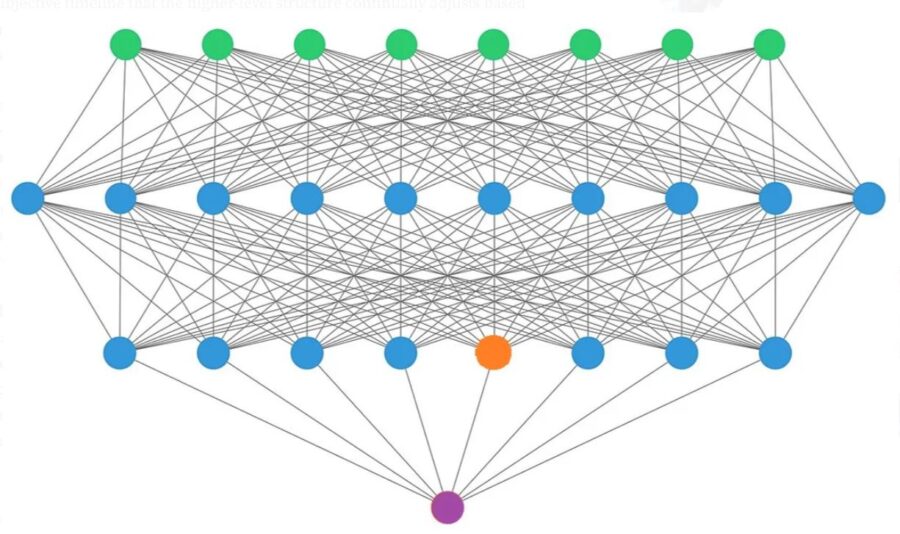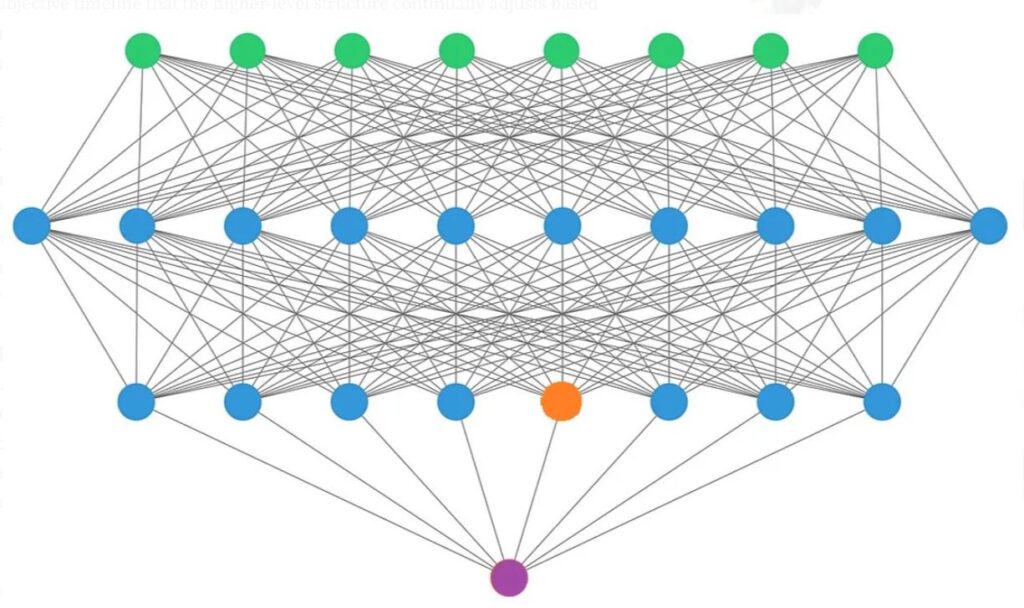
The objective of this blog post is to show that the observer effect, which is so puzzling in our physical world, has a logical explanation for a layer in a multilayers neural network and that that explanation involves a learning process. This post expands and further elaborates of a previous blog post by the author (Seidou Sand, 2023). Our analysis is built upon the free energy principle proposed by Friston (Schwartenbeck and al, 2013), which posits that a structure trying to survive within a given environment will develop an internal representation of that environment that mimeses its surprise.” It is under this framework that we examine the learning process of a multilayer neural network, which similarly aims to adapt to a specific environment by constructing a representation that reduces its surprise.
We are therefore assuming that a multilayer neural network is learning to survive in a specific environment and is therefore building a representation of its environment that minimises its surprise. The input for the neural network represents the true objective reality, while the output corresponds to the learned representation of this external reality. Consequently, the output can be regarded as the subjective world model of the neural network. Given the multi-layered structure of the network, the internal representation of the world is incrementally constructed through a series of successive layers. Each layer receives the representation of the world generated by the previous layer as its external reality, constructs its own internal representation, and subsequently passes this information to the succeeding layer. As a result, the neural network encompasses a system of nested internal representations, thereby creating an intricate hierarchy of interrelated worldviews.

Now, let’s look at the perspective of a neuron in a hidden layer of that structure. The neuron is unable to directly access the initial input (which could be seen as the “actual” objective reality), and instead, it obtains input that has undergone processing by earlier layers. If we think of the input the neuron gets as its external reality and the output as the subjective reality it constructs from its understanding of the objective reality, then we can perceive the different representations generated by neurons within a multi-layered neural network as a hierarchy of interconnected perspectives.

The notion of nested worldviews proposes that one structure’s external reality can serve as the subjective worldview for a higher-level structure. This higher-level structure, in turn, uses the external reality to form its internal worldview, which then becomes the subjective worldview of an even higher-level structure, and so on. This idea complements existing theories such as reality as information, reality as a simulation, and the supposed existence of lower and higher levels of consciousness in meditation practices.
One interesting feature of the nested worldviews model is its potential to explain the quantum wave function collapse in a simple manner. This so far mysterious phenomenon can be seen as a mere update of the internal representation of a higher-level structure in response to an observation made by a lower-level structure. For example, consider a red neuron within a neural network. This neuron receives information that has already been processed by previous layers and lacks access to objective external inputs (reality). Despite this limitation, the red neuron can learn from its input, update its state, and prompt an update of the entire neural network through a process called backpropagation. This change subsequently alters the input the neuron receives – an observation therefore leads to changes in external reality, the central enigma in quantum physics.
The nested worldviews model can also shed light on the retro causality phenomenon (Leifer & Pusey, 2017, Chou, 2022). In this scenario, the objective time of a lower-level structure is merely the subjective timeline that the higher-level structure continually adjusts based on new information. Retro causality occurs because our beliefs about the past can change as a result of what we learn today.
The nested worldviews theory aligns with several existing concepts, such as the learning universe theory (Alexander and al, 2021), the centrality of learning in life, and the idea that networks of observers (neurons) create objective reality (Lanza and Berman, 2019).
At first glance, it may seem counterintuitive to conceive that the solid, real reality we perceive is, in fact, the imagination or knowledge state of another entity. However, this notion is not entirely dissimilar from the implications of the simulation hypothesis.
The nested worldviews theory has far-reaching implications for our understanding of reality and how we perceive the world around us. By acknowledging the interconnected layers of interpretation that shape our reality, we can develop a more nuanced, empathetic, and inclusive approach to various aspects of our lives, from personal relationships to global concerns.
Our world is a complex web of interrelated systems, and many aspects of our lives involve nested structures. These structures encompass nested mathematical structures, nested biological organisms, nested ecosystems, nested brains, and nested computing in the form of decentralized computing. In light of these pervasive nested structures, the idea of nested worldviews as a natural aspect of our world becomes more compelling.
A nested worldview refers to a multi-layered approach to understanding reality, where each layer exerts an influence on the layers above and below it, shaping their comprehension of the world. In line with this framework, our external reality is an outcome of the worldview crafted by the layers that preceded us. As we interpret this reality, we develop our own unique perspective, which is subsequently passed on to the following layers. This continuous process of interpretation and transmission underscores the fluid nature of our understanding of reality, which is constantly evolving as new perspectives are created and disseminated.
The concept of nested worldviews offers numerous benefits when it comes to deciphering the world around us. By recognizing the multi-layered nature of reality, we are better prepared to appreciate the complexity and interconnectedness of the systems that govern our lives. This may be key in finding solutions to the current global challenges that arise from the world being a system of inter-dependant systems.
Furthermore, the dynamic nature of nested worldviews enables the continuous development of our understanding of reality. This adaptability is crucial in a rapidly changing world, as it encourages us to remain receptive to new ideas and viewpoints, fostering a culture of innovation and progress. It implies that our understanding of reality should never be static, but rather in a perpetual state of transformation as new insights are acquired and disseminated. This adaptability is vital for our survival in an increasingly complex world with global problems such as environmental preservation and climate action, emphasizing the importance of embracing nested worldviews as an inherent aspect of our existence.
The concept of nested worldviews brings forth an optimistic and refreshing perspective, suggesting that there is not just a simple dichotomy between the objective and the objective reality, but rather a diverse and ever-evolving landscape of interpretations. This idea supports the notion that the reality we perceive is an adaptive and dynamic dashboard shaped by evolution (Hoffman, 2019, Kastrup, 2019). It encourages a more fluid and vibrant understanding of the world, where multiple perspectives enrich one another.
The implications of nested worldviews are profound and far-reaching, impacting not only our self-perception but also our understanding of the world around us. This concept has the potential to foster growth and innovation across various fields of study. It presents an inspiring and insightful glimpse into the true nature of reality and our comprehension of it. Let’s hope that by recognizing and embracing the layers of interpretation that shape our world, we can cultivate a more empathetic, inclusive, and holistic approach to all aspects of our lives and ecosystems, ranging from personal relationships to global concerns such as global warming. This appreciation for the intricate tapestry of perspectives that constitute our collective reality may well pave the way for a more harmonious, interconnected, and united world. It may also add an element to the debate on whether AI will ever become conscious or not.
References:
Alexander, S., Cunningham, W. J., Lanier, J., Smolin, L., Stanojevic, S., Toomey, M. W., & Wecker, D. (2021). The autodidactic universe. arXiv preprint arXiv:2104.03902.
Chiou, D. W. (2022). Delayed-choice quantum eraser and the EPR paradox. arXiv preprint arXiv:2210.11375.
Hoffman, D. (2019). The case against reality: Why evolution hid the truth from our eyes. WW Norton & Company.
Kastrup, B. (2019). The idea of the world: a multi-disciplinary argument for the mental nature of reality. John Hunt Publishing.
Lanza, R., & Berman, B. (2010). Biocentrism: How life and consciousness are the keys to understanding the true nature of the universe. BenBella Books, Inc..
Leifer, M. S., & Pusey, M. F. (2017). Is a time symmetric interpretation of quantum theory possible without retrocausality?. Proceedings of the Royal Society A: Mathematical, Physical and Engineering Sciences, 473(2202), 20160607.
Schwartenbeck, P., FitzGerald, T., Dolan, R. J., & Friston, K. (2013). Exploration, novelty, surprise, and free energy minimization. Frontiers in psychology, 4, 710.
Seidou Sanda, I. (2023). Nested Worldviews: Can Neural Networks Unlock the Secrets of Reality? Medium, https://medium.com/@issoufouseidousanda/nested-worldviews-can-neural-networks-unlock-the-secrets-of-reality-4304f7057a9e
